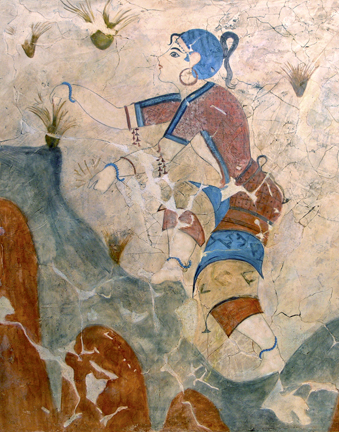
The Art of Ancient Civilizations
Reproduced by Thomas Baker
Thomas Baker Paintings Home Page

"The Saffron Gatherer"
A reproduction of an ancient Theran wall mural
(approx. 3600 years old) by Thomas Baker
48 X 48 inches, oil on plaster-textured wood panel
This painting is available for purchase: $7500.00
(See also Thomas Baker's painting, "Ariadne," which is also based on the Theran frescoes)
Prints of this painting are available--click here for prices and ordering info
Thomas Baker Paintings Home Page
|
Gathering Flowers on the Doomed Island of Atlantis This scene is part of a larger wall mural from an excavated room in a collapsed building known as xeste 3, in the ancient buried city of Akrotiri, which is on the Mediterranean island today known as Santorini or Thera. Akrotiri is the Pompeii of the Aegean Islands, and was buried by volcanic ash under similar conditions, although much earlier (Late Bronze Age or 1628 BC for Thera vs 79 AD for Pompeii). The painting shows women wearing typical Minoan costumes gathering crocus flowers from which the spice and dye saffron is made. The buried city which has been named Akrotiri (no one knows what the ancients called it, since we do not know their language and cannot translate their writing) is so large that archaeologists have estimated that it will take 300 years at the present rates of excavation to expose it. The layers of volcanic ash which buried Thera are over 150 feet deep on some parts of the island, and cover Akrotiri itself to about 20 feet, so that digging up the city has resembled a mining operation at times. According to Charles Pellegrino in his book Unearthing Atlantis, a hole drilled a mile away from the present dig also struck part of the ancient city, showing the extent of the work that lies ahead. Thera was a colony of the Minoan culture of Crete, where the Minoans built large palaces, and shared many aspects of the mother island's artistic style. These paintings were frescoes, that is, paintings on wet plaster (for more information on Theran frescoes go here). It is likely that many more such paintings will be discovered in the years to come, giving us priceless information about Theran lifestyle and technology, which was far advanced over that of surrounding peoples on the Greek mainland. The mainland peoples, probably considered barbarians by the Therans, regarded Thera and its inhabitants with an awe that survives yet in the legends of Atlantis. The ancient inhabitants of the island of Thera were quite aware that they had built their city on a volcanic island, as evidenced in this painting in the black and red volcanic stone and soil on which the girl is gathering her flowers. Minoan cities had been shaken apart by major earthquakes, repaired and rebuilt many times before the unimaginably violent volcanic blast of 1628 BC that hurled much of the island into the sky and buried Akrotiri. The people of Thera were so accustomed to seismic tremors that their buildings were designed to be flexible enough to withstand them. However, although a recent earthquake had seriously damaged Akrotiri and repairs to its buildings were in progress right up until the end, the actual volcano of Santorini had been quiet since beyond their memory. But just before it exploded, leaving a vast hole in the earth that was quickly filled by the sea, the island must have shuddered violently again or given some other warning of the imminent disaster (perhaps the initial stages of the eruption), since so far no human remains have been found in the rubble of the city. Many small items such as jewelry are also absent, suggesting that the inhabitants of the city had time to grab small valuables and flee, leaving less portable items such as furniture behind (the bedrooms still have their beds). The disaster apparently caught some of the mural painters working on their paintings, as evidenced by jars of dried-out paint and plaster found with some unfinished frescoes. Whatever terrible event interrupted them, the artists dropped their brushes and joined the rest of the populace in its flight to wherever they went, probably to ships in the harbor. As Pellegrino has said in his book, maybe someday on Thera heaps of skeletons with sacks of valuables will be unearthed where the ancient seashore once was, where crowds of refugees died trying to board ships, just as happened at Pompeii (in fact, during pumice mining operations on Thera in the 1800's one such body was found). For now, however, the fate of the former inhabitants of Akrotiri remains a mystery. (For more information on Thera see this website.) Adding to the likelihood that Thera is the Atlantis of legend, archaeologists are finding such advanced technology as flushing toilets (which drained into underground sewers), what appears to have been hot running water in the bathrooms, and buildings that may have been heated in winter by steam or hot circulating water in ceramic pipes (perhaps water from thermal springs associated with the volcano). Some Minoan jewelry also appears to have been electroplated--all this nearly four thousand years ago. Perhaps in some wall mural yet to be discovered, some of these technological wonders will be revealed through the art of the painter. (Elements of the Minoan dress shown in the above fresco and others were replicated and worn by a model to create a new painting, "Ariadne" (see thumbnail below; click to enlarge) |
"Ariadne"
Prints of this painting are available here
Return to Ancient Civilizations painting reproductions
Thomas Baker Paintings Home Page
Original paintings by Thomas Baker Group 1 | Group 2 | Group 3 | Group 4
Portraits | Old Masters copies | Ancient civilizations reproductions | Prehistoric reproductions
About the Artist | Contact Thomas Baker